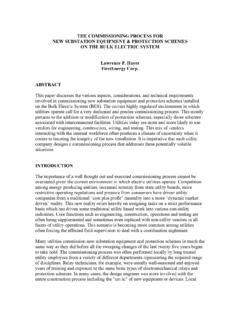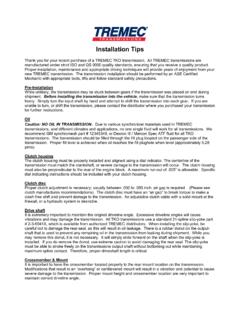Transcription of Part One: Seminar Hammer throwing training points from ...
1 1 Report on the International Hammer throwing SeminarAnd Szombathley Hammer Throw training Center ProgramHarold ConnollyThe following is a report compiled by Harold Connolly for the USATF about the InternationalHammer throwing Seminar and the Hammer throw training Center in Szombathley. The firstsection contains information about the presentations by Anatoly Bondarchuk, and Iouri Sedykh,and the second part contains information from Pal Nemeth about the Hammer throw TrainingCenter in Szombathley. At the conclusion of this article you will find some recommendations forthe USATF for the future of Hammer throwing in the One: Seminar Hammer throwing training points from AnatolyBondarchuk and Iouri SedykhIn the '50s and '60s American Hammer throwers did primarily only two forms of physicaltraining. They threw the Hammer and 35-pound weight and used only weightlifters and powerlifters exercises.
2 A positive reaction of the thrower s body decreases with using the samenarrow scope of physical exercises. After 4 to 6 years of improved throwing performances,improvement stops because of a lack of a variety of stimuli to the athlete's body. The theory ofmany years of general preparation in Hammer throw training is the late 1970s and early '80s high intensity and specific training for the Hammer closerto the Hammer throw angles was added to the Hammer throwers training and employed from thevery beginning of trainingBased on the coaches assessment of athletes specific physical and psychological needs,they prescribe for each athlete regularly varied complexes of exercises derived from 150 to 200physical movements in repeated sets of repetitions of approximately 8 to 10 different physicalmovements or drills, including Hammer and weight throwing , varied types of running, longrunning, sprinting, jumping, weight training , other resistance exercises, swimming, relays, ballgames, and gymnastics the complexes of exercises the sets, repetitions, and poundages can be varied.
3 Butthe order of the exercises should remain the same. If the complex begins with throwing exercisesand concludes with power exercises, it should remain the same otherwise the athlete s brainbecomes all athletes there are three stages: a growth phase with improving performances, astabilization or maintenance phase during which the athletes performances remain essentiallylevel, and a period of declining growth phase in Hammer throwers development usually occurs until the athlete isapproximately 25 - 26 years of age. The maintenance phase generally lasts from 26 - 33 years ofage, and the stage of decline begins at approximately 34 to 35 years of age when the throwerbegins to have less adrenaline and fewer nerve European research has found that by regularly changing the complexes ofexercises (the athletes training stimuli) every three or four weeks or when he/she has asignificant throwing performance improvement, the thrower s growth, stabilization, anddeclining phases can be lengthened.
4 Employing novelty of physical movements, includingperiodic fun physical activities, obviates mental boredom and physical estimates it can take 6 to 8 years to achieve 65 - 70 m results, another 52years to achieve 73 - 78 m results, and another 5 years to achieve 80 m+ results with a rhythm is the most important thing to learn. The athlete must throw at 82 % to90 % effort to attain competition- throwing rhythm. To attain this rhythm, the coach must findcauses or roots of the technical mistakes made by the thrower. It can take a year to change badtechnique and results will probably decrease. The athlete must successfully make the adjustmentsto improve technique in order to begin improving performance throwing Biomechanical points : The Hammer can only be accelerated when both feet are on the ground. The winds are the beginning of Hammer s acceleration.
5 On entry the Hammer planeshould not be excessively steep but more horizontal. In the two legged stance (double support) the Hammer s acceleration stops when thehammer reaches zero degrees and the shoulder and hip axes are no longer separated. After accelerating the Hammer to zero degrees let the Hammer turn the body. Do not havethe body turn the Hammer . Let the Hammer turn the left foot and lift off the right foot. Thefaster the Hammer is accelerated the quicker the right foot lifts off. From the right foot touch down accelerate the Hammer to 0 degrees, relax, and let thehammer s orbits make the turns of the body. Use the Hammer to move the Hammer body system throughout the turns and into therelease. If the athlete does not let the Hammer make the turns, he will lose speed in the Norms for 80m + ThrowersIn Table 1 are someestimates on performance normsfor 80m+ throwers.
6 These normsare estimates, the following ofwhich have significantly highercorrelation to predict 80 m + Hammer performance than others:snatch, vertical jump, and have found that a 155kilogram snatch and a 320 kg squathave no increased influence onhammer throw performance, andthey recommend that emphasis onattempting to improve performances in all these norms should be decreased after the athlete hasreached the 70 m + level of Hammer throw performance. At that point even greater emphasisshould be given to varying the complexes of exercises for Hammer throw 1: Exercises performances norms with possiblecorrelations to 80 m + Hammer throwing Snatch,130 140 kgPower Clean,180 -190 kgSquat,270-280 kgShot Backwards,22- 23 mShot Forwards, mStanding Triple Jump, - mStanding Long Jump, - mVertical Jump,.90 - m6 kg Hammer ,92 m8 kg Hammer ,75 - 76 mCrouch Start Sprint 30 m, secs3 part Two: Hammer training at the Szombathley training CenterAthletes report for training afterschool or after work Monday throughFriday between 2 and 3:30 are divided into six groupsof mixed genders and ability of youngand older approximately 2-hourtraining session begins with the groupsjogging, stretching, and performingmultiple turns on the aprons of the trackor on the practice soccer field.
7 They doat least 5 sets of no fewer than 10 turns with the Hammer . Multiple turn drills develop stabilityand basic Hammer throwing coaches comments emphasize the positive performance of the athlete; they do notconcentrate on the hammers and/or throwing weights weigh 2 kg, 3 kg, kg, 4 kg,5 kg, 6 kg, kg, kg, 9 kg, 10 kg, kg, kg, 16 kg, and 20 10 12 years-of-age train primarily with 2, 3, and kg hammers. Theycompete with 2 and 3 kg hammers. 13 15 year-olds train primarily with 4 and 5 kg hammers,and they compete with 4 kg hammers. 16 and 17 year-olds train with 5 and 6 kg hammers andcompete with 5 throwers make 25 to 30 throws each training session, usually with two or threedifferent weighted hammers and weights. In 26 weeks they take a minimum of 4,010 Saturdays they train at 9 AM in the morning and a second session in the competitions are held on and 12 -year-old athletes also incorporate a wide variety of exercises and drills tostrengthen all parts of their bodies.
8 Their complexes of exercises are also changed training is introduced at ages 13 14 with wooden plates approximately the same size asOlympic plates in order to teach correct lifting technique. Athletes begin with a maximum of 25to 30 kilos and progressively increase the resistance. All athletes daily weight training workoutstake approximately 20 minutes. For their hurdling drills youngsters use plastic hurdles to they grow into adolescence when athletes break the wires, they are taught to cuthammer wire from large reels and rewire their hammers. All athletes at the training Center are taught and regularly reminded to be very cautiousabout accidents. They use caged-in, parallel throwing circles where one athlete after anotherfrom the lined up groups steps into the two throwing cages to take alternate throws afterreceiving a signal from a teammate and looking himself or herself to see that the throwing area isclear.
9 After everyone has taken 2 throws, they all go into the field to retrieve their groups of less proficient throwers use a third caged throwing circle at the far end of thethrowing coach looks back and forth between the 2 adjacent circles, giving occasionalTable 2: Athletes training at the SzombathleyTraining CenterAgeNumberMaleFemale101112 1516 1819 2324 + older22141162119641115521 Totals3722154encouragement or instruction to the throwers. They proceed throwing without wasting any timeand do not wait for comments from the coach. Completing the assigned daily volume of throwsand training complex of exercises within the prescribed time is the day s training competitions they follow the same varied complexes of exercises training systemonly reducing the intensity. If an athlete usually takes 10 maximum throws of his 25 or 30 in atraining session, he/she will take only 5 maximum throws and reduce intensity in the otherworkout exercises the week before a competition.
10 New young athletes are given a Hammer , encouraged to practice what they can at home,and after approximately two or three weeks of training are introduced to competition. Improvingtheir throwing results from competition to competition develops a positive attitude. Young throwers receive motivational certificates of accomplishment. There are goldsilver andbronzethrowing levelsof achievementfor under 14-year-olds, 15-year-olds, 16 -17-year-olds,and 18 - reachthe goldcategory (seeTable 3) intheir age group,a 1,000 metersswim at 6 AM every Tuesday and Thursday morning before school or employment is added totheir training the end of November until the middle of March, they train indoors in the sportshall. On Monday and Friday they do medicine ball drills, jumping exercises, multiple hammerturns the length of the basketball court, gymnastics movements, and various other complexes ofmovements.







